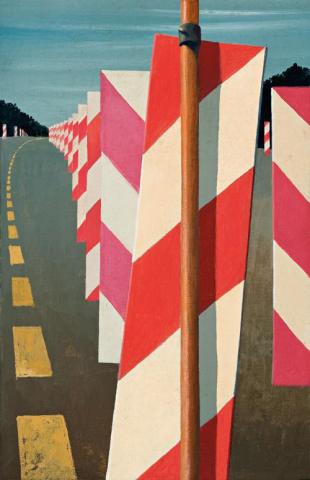STUDY FOR AUTOBAHN IN BLACKFOREST II, 1979
Jeffrey Smart
oil on canvas
43.0 x 29.0 cm
signed lower left: Jeffrey Smart
Rudy Komon Galleries, Sydney (label attached verso)
Private collection, Brisbane
Jeffrey Smart: Recent Paintings, Redfern Gallery, London, 11 November - 4 December 1982
Jeffrey Smart: Recent Paintings, Australian Galleries, Melbourne, 22 March - 9 April 1983
Malouf, D., 'Jeffrey Smart - Recent Works', Art International, vol. XXV/9, 1982, p.69
Quartermaine, P., Jeffrey Smart, Gryphon Books, Melbourne, 1983, pp. 72, 116 (cat.739)
McDonald, J., Jeffrey Smart: Paintings of the 70s and 80s, Craftsman House, Sydney, 1990, p.159 (cat.202)
Capon, E., Jeffrey Smart: Retrospective, Art Gallery of New South Wales, Sydney, 1999, p.13
Autobahn in Blackforest II, 1979-80, oil and synthetic polymer paint on canvas, 99.0 x 64.5cm (Quartermaine, cat.740);
Autobahn in Blackforest I, 1979-80, oil and synthetic polymer paint on canvas, 74.0 x 90.0cm (Quartermaine, cat.738);
Panel Studies for Autobahn Blackforest, 1979, oil and synthetic polymer paint on canvas, 52.0 x 45.5cm (Quartermaine, cat.736)
Encapsulating the artist's unerring instinct for the beauty of modern signs and symbols, the 'Blackforest Autobahn' series 1979-80 is without doubt among Jeffrey Smart's most iconic and widely celebrated.
Like Cézanne, Smart's priority has always been the pursuit of the consummate composition - as articulated eloquently in his oft-quoted adage, 'the subject matter is only the hinge that opens the door, the hook upon which one hangs the coat.'1 Yet, unlike compositions that betray a sense of evolvement, Smart's paintings bear a remarkable quality of planned completion that is usually aided by a single dominant feature- in the present case, the beautifully rhythmic red and white road signs which lead the viewer to a dramatic horizon and mysteries of an unseen vista beyond. First appearing in The Red Arrow compositions of 1973, the use of the red and white chevron signs here demonstrates well the artist's manipulation of the formal qualities of his subject against literal demands: our knowledge of roads suggests the signs must be receding into the distance, yet in Smart's image, they merge to form a single harmonious surface, unified in colour and design. As Quartermaine muses, '...art and life, if not one, at least teasingly coincide; road signs will never be the same again.'2
Arguably one of the great paradoxes of Smart's achievement is that symbols of modernity, pressure and activity such as the autostrada should be imbued with an aura of timeless serenity reminiscent of the classical compositions of Piero della Francesca. In stark contrast to his Renaissance predecessor, however, the element of stillness in Smart's work is decidedly more disturbing- perhaps because 'we still find it oddly beyond belief that practical and mundane familiarities like roads and railways should be elevated to the status of semi-mystic icons.'3 Thus focussing our attention on the formal qualities of his immaculate compositions such as the present Study for Autobahn in Blackforest II 1979, Smart encourages his audience to see the everyday with fresh eyes, to discern beauty in the most unromantic subjects. As Quartermaine reiterates, '...Smart's paintings are not to be looked through but looked at. If we look through them we find only the preconceptions we brought with us- by looking at them with the attention they demand we can experience their world.'4
1. Smart cited in Jeffrey Smart Retrospective, Art Gallery of New South Wales, Sydney, 1999, p.14
2. Quartermaine, P., Jeffrey Smart, Gryphon Books, 1983, p.74
3. Capon, E., 'Still, Silent, Composed: The Art of Jeffrey Smart' in Jeffrey Smart, 1999, op.cit. p.16
4. Quartermaine, op.cit., p.78
VERONICA ANGELATOS
